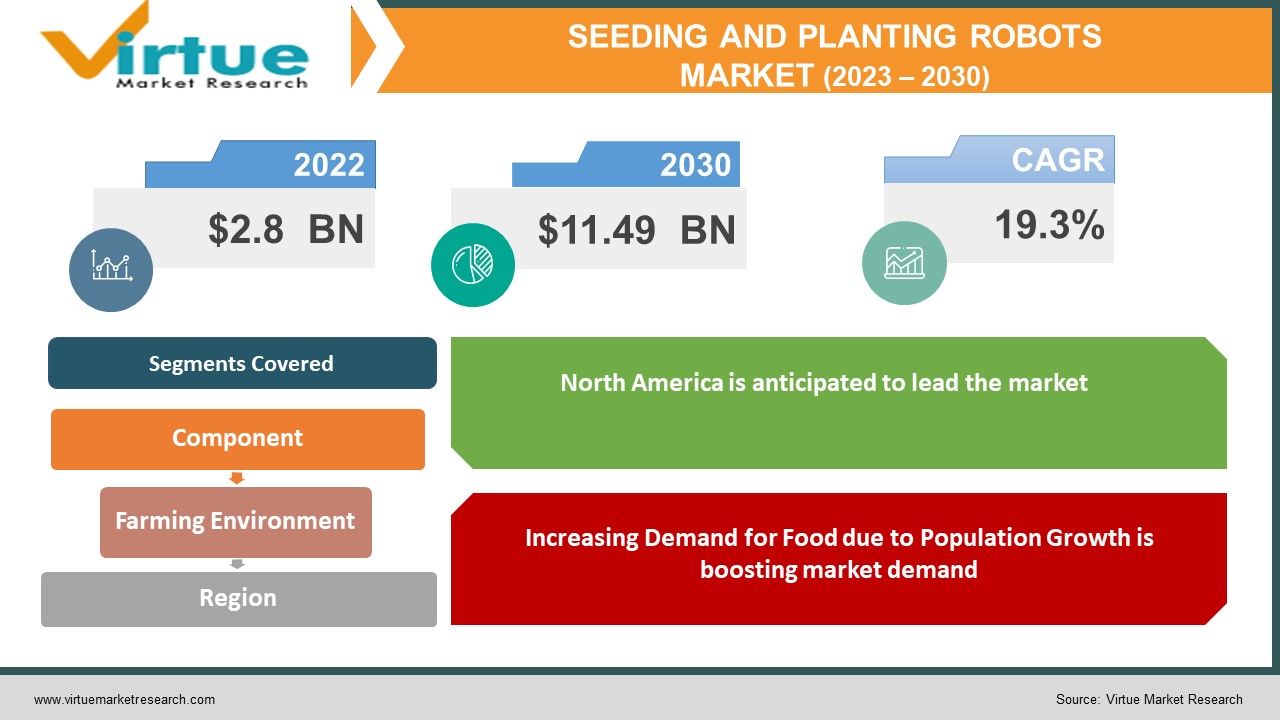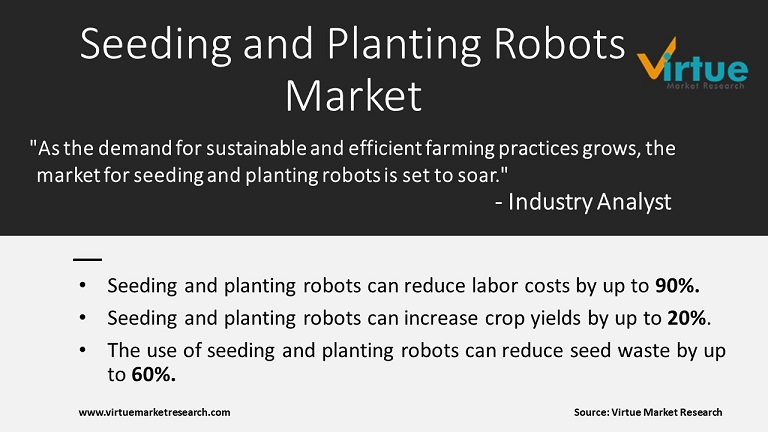Seeding and Planting Robots Market Size (2023-2030)
Global Seeding and Planting Robots Market was estimated to be worth USD 2.8 Billion in 2022 and is projected to reach a value of USD 11.49 Billion by 2030, growing at a CAGR of 19.3% during the forecast period 2023-2030.

One type of agricultural robot that helps farmers automate the planting process is the seeding and planting robot. In a society where the demand for food is rising swiftly, the capacity of these machines to plant crops far more quickly than individuals can is quite advantageous. They also offer more accurate planting, which can enhance resource management and boost crop production. The well-known maker of agricultural equipment John Deere is a significant player in the seeding and planting robot business. The business has developed several planting robot models that make greater and more accurate use of contemporary technology. These robots utilize high-resolution sensors to scan the soil and determine the best planting method for each type of crop, which could lead to better results.
As farmers explore ways to boost productivity and efficiency while simultaneously minimizing their environmental impact, the market for seeding and planting robots is anticipated to grow. We can project seeing even more innovation in this field as more businesses enter the market and technology advances.
Global Seeding and Planting Robots Market Drivers:
Increasing Demand for Food due to Population Growth is boosting market demand.
As a result of the expanding population, there will be a greater need for food, which will put pressure on farmers to increase crop output. Seeding and planting robots can help farmers satisfy this need by enabling more precise planting and lowering the time and effort required for planting. Robotic seeding and planting allow farmers to plant crops far more quickly than they can with human labour, which is essential during the busiest planting seasons. The robots can more precisely plant crops because they can set each seed at the right depth and spacing for optimum yield. Additionally, this accuracy can help with resource management and waste reduction, two important aspects of sustainable agriculture.
Rising Labor Costs and Labour Shortages are driving market growth for these seeding and planting robots.
Farmers are under pressure to discover ways to lower labour costs since labour costs have been rising across the globe. By automating the planting process, seeding and planting robots can assist farmers in lowering their labour expenses. Farmers can save labour costs and divert resources to other parts of their business by deploying these robots. Labour shortages are another element influencing the need for seeding and planting robots. It might be challenging for farmers to timely sow crops due to a shortage of agricultural hands in many parts of the world. Robotic seeding and planting can help with this shortfall by acting as a substitute for physical labour. Without the need for pauses or relaxation periods, these robots can operate nonstop while planting crops rapidly and effectively. Robots for sowing and planting crops also lessen the possibility of human error while maximizing crop productivity. Hence boosting productivity, accuracy, and yield and offering a solution to the issues of labour costs and labour shortage in the agricultural sector.

Global Seeding and Planting Robots Market Challenges:
The expensive cost of these devices is one of the main issues hindering the industry of seeding and planting robots. Robots for seeding and planting demand sophisticated technology and specific parts, which might raise the cost of production. Many farmers may find it difficult to embrace these tools because of their high prices, particularly those who operate smaller farms or in developing nations with few resources. Because of this, businesses that create these devices must figure out how to lower production costs so that farmers can access and buy them.
COVID-19 Impact on Global Seeding and Planting Robots Market:
Due to pandemic-related supply chain disruptions, manufacturing process delays, and staffing issues, the production and delivery of seeding and planting robots were postponed. Demand for this equipment decreased as a result of farmers' diminished financial resources as a result of the pandemic's negative economic effects. Farmers found it increasingly difficult to acquire and manage labour as a result of the outbreak, highlighting the need for automation in the sector. As a result of its increasing acceptance as a remedy for these problems, robotic seeding and planting have seen greater investment and innovation. The pandemic has also accelerated the development of digital agricultural techniques, opening up new market potential for companies that make seeding and planting robots.
Global Seeding and Planting Robots Market Recent Developments:
- In February 2022, for growers of speciality crops, Verdant Robotics created a more thorough robots-as-a-service (RaaS) strategy. The business's multi-action autonomous farm robot does laser weeding, millimetre-accurate spraying, and digital crop modelling using artificial intelligence. Farmers can benefit from the strategy in several ways, including as better production, larger yields, and significant cost savings. Verdant Robotics has raised $21.5 million since its founding in 2018 for the creation of its farm robot.
- In June 2022, for sustainable farming, the Small Robot Company (SRC) released its Per Plant Farming robot services. Significant reductions in the use of fertilizers and herbicides have been shown in pilot studies. 50 farms will have access to SRC's fully autonomous crop-scanning service beginning this fall. The robot services will be the first of their sort to be used commercially in Britain.
SEEDING AND PLANTING ROBOTS MARKET REPORT COVERAGE:
|
REPORT METRIC |
DETAILS |
|
Market Size Available |
2022 - 2030 |
|
Base Year |
2022 |
|
Forecast Period |
2023 - 2030 |
|
CAGR |
19.3% |
|
Segments Covered |
By Component, Farming Environment, and Region |
|
Various Analyses Covered |
Global, Regional & Country Level Analysis, Segment-Level Analysis, DROC, PESTLE Analysis, Porter’s Five Forces Analysis, Competitive Landscape, Analyst Overview on Investment Opportunities |
|
Regional Scope |
North America, Europe, APAC, Latin America, Middle East & Africa |
|
Key Companies Profiled |
Agrobot, Blue River Technology, Harvest Automation, Precision Hawk, AGCO Corporation, AG Eagle LLC, Agribotix LLC, Lely Industries, Naio Technologies, Precision Hawk, Deere & Company, Trimble, IBM |
Global Seeding and Planting Robots Market Segmentation:
Global Seeding and Planting Robots Market Segmentation: By Component
- Hardware
- Software
- Services
Hardware, software, and services can be used to segment the global seeding and planting robots market. Given that the hardware category comprises the actual tools needed for seeding and planting, it is anticipated that this segment will dominate the market. Due to the arising implementation of AI and machine learning technologies for crop production optimization and planting pattern optimization, the software segment is anticipated to rise at a quicker rate. Due to the rising demand for support and maintenance services for these devices, the services segment—which includes maintenance, repair, and installation services is also anticipated to expand. Due to the increased adoption of precision agricultural technology in these regions, North America is anticipated to dominate the market, followed by Europe and Asia-Pacific.
Global Seeding and Planting Robots Market Segmentation: By Farming Environment
- Indoor Farming
- Outdoor Farming
The market for seeding and planting robots may also be divided into indoor and outdoor farming based on the type of farming environment. Given that outdoor farming is more traditional and utilizes a bigger amount of farmland, it is predicted to dominate the market. However, due to the rising popularity of vertical farming and the demand for more effective and sustainable food production techniques, the indoor farming market is anticipated to expand more quickly. The development of LED lighting and temperature control technologies, which can produce the best-growing conditions for crops, is also anticipated to have a positive impact on the indoor farming market.
Global Seeding and Planting Robots Market Segmentation: By Region
- North America
- Europe
- Asia Pacific
- South America
- Middle East & Africa
North America, Europe, Asia Pacific, South America, and the Middle East & Africa are the regions into which the worldwide seeding and planting robots market may be divided. Due to the high rate of adoption of precision agricultural technology, rising investment in ag-tech start-ups, and a significant concentration of important players in the region, North America is anticipated to lead the market. Due to its supporting government regulations, rising adoption of automation and precision agriculture technology, and other factors, Europe is also anticipated to hold a sizable portion of the market. Due to factors including the arising need for food from a growing population, the scarcity of arable land, and the need for more effective farming techniques, the Asia-Pacific region is predicted to experience tremendous expansion. Due to the increased acceptance of precision agriculture technology and growing understanding of the advantages of seeding and planting robots, South America and the Middle East & Africa are anticipated to have relatively smaller market shares but have growth potential.
Global Seeding and Planting Robots Market Key Players:
- Agrobot
- Blue River Technology
- Harvest Automation
- Precision Hawk
- AGCO Corporation
- AG Eagle LLC
- Agribotix LLC
- Lely Industries
- Naio Technologies
- Precision Hawk
- Deere & Company
- Trimble
- IBM
Chapter 1. SEEDING AND PLANTING ROBOTS MARKET – Scope & Methodology
1.1. Market Segmentation
1.2. Assumptions
1.3. Research Methodology
1.4. Primary Sources
1.5. Secondary Sources
Chapter 2. SEEDING AND PLANTING ROBOTS MARKET – Executive Summary
2.1. Market Size & Forecast – (2023 – 2030) ($M/$Bn)
2.2. Key Trends & Insights
2.3. COVID-19 Impact Analysis
2.3.1. Impact during 2023 – 2030
2.3.2. Impact on Supply – Demand
Chapter 3. SEEDING AND PLANTING ROBOTS MARKET – Competition Scenario
3.1. Market Share Analysis
3.2. Product Benchmarking
3.3. Competitive Strategy & Development Scenario
3.4. Competitive Pricing Analysis
3.5. Supplier - Distributor Analysis
Chapter 4. SEEDING AND PLANTING ROBOTS MARKET - Entry Scenario
4.1. Case Studies – Start-up/Thriving Companies
4.2. Regulatory Scenario - By Region
4.3 Customer Analysis
4.4. Porter's Five Force Model
4.4.1. Bargaining Power of Suppliers
4.4.2. Bargaining Powers of Customers
4.4.3. Threat of New Entrants
4.4.4. Rivalry among Existing Players
4.4.5. Threat of Substitutes
Chapter 5. SEEDING AND PLANTING ROBOTS MARKET - Landscape
5.1. Value Chain Analysis – Key Stakeholders Impact Analysis
5.2. Market Drivers
5.3. Market Restraints/Challenges
5.4. Market Opportunities
Chapter 6. SEEDING AND PLANTING ROBOTS MARKET – By Component
6.1. Hardware
6.2. Software
6.3. Services
Chapter 7. SEEDING AND PLANTING ROBOTS MARKET – By Farming Environment
7.1. Indoor Farming
7.2. Outdoor Farming
Chapter 8. SEEDING AND PLANTING ROBOTS MARKET – By Region
8.1. North America
8.2. Europe
8.3.The Asia Pacific
8.4.Latin America
8.5. Middle-East and Africa
Chapter 9. SEEDING AND PLANTING ROBOTS MARKET – Company Profiles – (Overview, Product Portfolio, Financials, Developments)
9.1. Agrobot
9.2. Blue River Technology
9.3. Harvest Automation
9.4. Precision Hawk
9.5. AGCO Corporation
9.6. AG Eagle LLC
9.7. Agribotix LLC
9.8. Lely Industries
9.9. Naio Technologies
9.10. Precision Hawk
9.11. Deere & Company
9.12. Trimble
9.13. IBM
Download Sample
Choose License Type
2500
4250
5250
6900
Frequently Asked Questions
Global Seeding and Planting Robots Market was estimated to be worth USD 2.8 Billion in 2022 and is projected to reach a value of USD 11.49 Billion by 2030, growing at a CAGR of 19.3% during the forecast period 2023-2030
The Global Seeding and Planting Robots Market is driven by the Increasing Demand for Food due to Population Growth.
The Segments under the Global Seeding and Planting Robots Market by the Farming Environment are Indoor Farming, Outdoor Farming.
China, Japan, South Korea, Singapore, and India are the most dominating countries in the Asia Pacific region for the Global Seeding and Planting Robots Market
Agrobot, Blue River Technology, and Harvest Automation are the three major leading players in the Global Seeding and Planting Robots Market.



